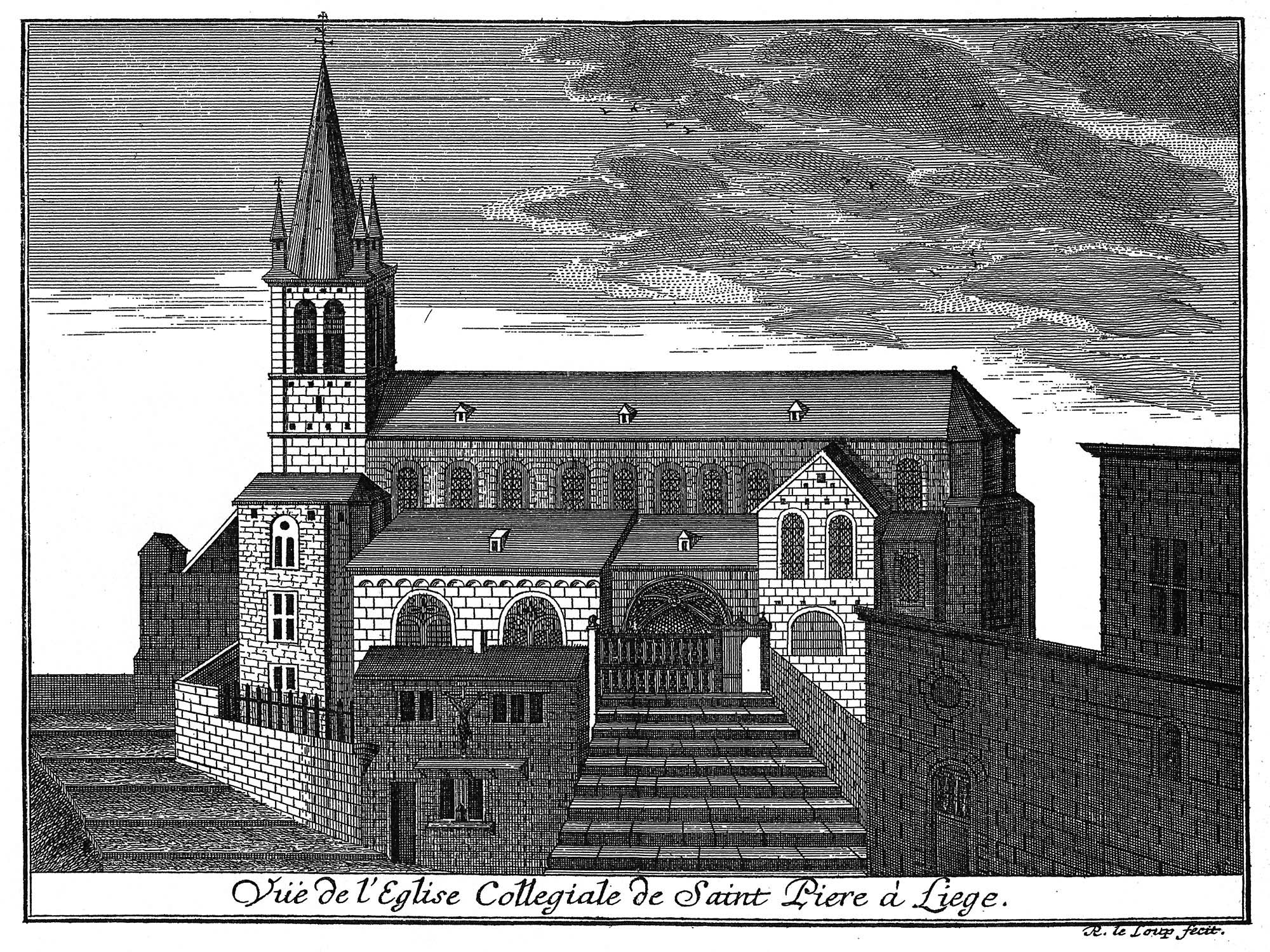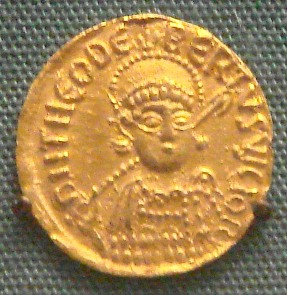|
St Peter's Church, LiĆØge
St Peter's Church (French - ''CollĆ©giale Saint-Pierre'') was a church in LiĆØge. It was founded in 712 by bishop Hubertus on the site of a Merovingian cemetery (the latter was rediscovered in the 19th century) and construction began that same year. Intending it as a monastery church, the bishop also built a cloister and brought in 15 monks from Stavelot Abbey. On his death in 727, the church's crypt became Hubert's first resting place, before his body was moved to Andage (now Saint-Hubert) in the Ardennes. The Vikings destroyed the original church in 914 and a new one was built and consecrated in 931. In 945 it was made a collegiate church with 30 secular canons. It was damaged by fire in 1185 but eleven years later had recovered enough to host a synod. It was finally closed in 1797 in the wake of the LiĆØge Revolution The LiĆØge Revolution, sometimes known as the Happy Revolution (french: Heureuse RĆ©volution; wa, BinamĆŖye revolucion), against the reigning prince-bisho ... [...More Info...] [...Related Items...] OR: [Wikipedia] [Google] [Baidu] |
LiĆØge
LiĆØge ( , , ; wa, LĆ®dje ; nl, Luik ; german: LĆ¼ttich ) is a major city and municipality of Wallonia and the capital of the Belgian province of LiĆØge. The city is situated in the valley of the Meuse, in the east of Belgium, not far from borders with the Netherlands (Maastricht is about to the north) and with Germany (Aachen is about north-east). In LiĆØge, the Meuse meets the river Ourthe. The city is part of the '' sillon industriel'', the former industrial backbone of Wallonia. It still is the principal economic and cultural centre of the region. The municipality consists of the following districts: Angleur, , ChĆŖnĆ©e, , GrivegnĆ©e, Jupille-sur-Meuse, LiĆØge, Rocourt, and Wandre. In November 2012, LiĆØge had 198,280 inhabitants. The metropolitan area, including the outer commuter zone, covers an area of 1,879 km2 (725 sq mi) and had a total population of 749,110 on 1 January 2008. [...More Info...] [...Related Items...] OR: [Wikipedia] [Google] [Baidu] |
Hubertus
Hubertus or Hubert ( 656 ā€“ 30 May 727 A.D.) was a Christian saint who became the first bishop of LiĆØge in 708 A.D. He is the patron saint of hunters, mathematicians, opticians and metalworkers. Known as the "Apostle of the Ardennes", he was called upon, until the early 20th century, to cure rabies through the use of the traditional Saint Hubert's Key. Hubert was widely venerated during the Middle Ages. The iconography of his legend is entangled with the legend of the martyr Saint Eustace. The Bollandists published seven early lives of Hubertus (''Acta Sanctorum'', November 3, 759 ā€“ 930 A.D.); the first of these was the work of a contemporary, although it offers few details. Hubertus died 30 May 727 A.D. in or near a place called (in Latin) ''Fura''. In the later Middle Ages, this location was claimed to have been identified as Tervuren near Brussels; recent scholarship, however, considers Voeren (Fourons), a location much closer to LiĆØge than Brussels, to be the saint's l ... [...More Info...] [...Related Items...] OR: [Wikipedia] [Google] [Baidu] |
Merovingian
The Merovingian dynasty () was the ruling family of the Franks from the middle of the 5th century until 751. They first appear as "Kings of the Franks" in the Roman army of northern Gaul. By 509 they had united all the Franks and northern Gaulish Romans under their rule. They conquered most of Gaul, defeating the Visigoths (507) and the Burgundians (534), and also extended their rule into Raetia (537). In Germania, the Alemanni, Bavarii and Saxons accepted their lordship. The Merovingian realm was the largest and most powerful of the states of western Europe following the breaking up of the empire of Theodoric the Great. The dynastic name, medieval Latin or ("sons of Merovech"), derives from an unattested Frankish form, akin to the attested Old English , with the final -''ing'' being a typical Germanic patronymic suffix. The name derives from King Merovech, whom many legends surround. Unlike the Anglo-Saxon royal genealogies, the Merovingians never claimed descent from a ... [...More Info...] [...Related Items...] OR: [Wikipedia] [Google] [Baidu] |
Stavelot Abbey
The Princely Abbey of Stavelot-Malmedy, also Principality of Stavelot-Malmedy, sometimes known with its German name Stablo, was an ecclesiastical principality of the Holy Roman Empire. Princely power was exercised by the Benedictine abbot of the imperial double monastery of Stavelot and Malmedy, founded in 651. Along with the Duchy of and the Prince-Bishopric of , it was one of only three principalities of the Southern Netherlands that were never part of the Spanish, later Austrian Netherlands, which after 1500 were assigned to the Burgundian Circle while the principalities were assigned to the Lower Rhenish Imperial Circle. As a prince-abbot, the abbot of Stavelot-Malmedy sat on the Ecclesiastical Bench of the College of Ruling Princes of the Imperial Diet alongside the prince-bishops. Along with the handful of other prince-abbots, he cast a full vote ('),Number 67 of the princely college. in contrast to the majority of imperial abbots who were only entitled to collectiv ... [...More Info...] [...Related Items...] OR: [Wikipedia] [Google] [Baidu] |
Abbey Of Saint-Hubert
The Abbey of Saint-Hubert, officially the Abbey of St Peter in the Ardennes (''Abbaye de Saint-Pierre en Ardennes''), was a Benedictine monastery founded in the Ardennes in 687 and suppressed in 1797. The former abbey church is now a minor basilica in the diocese of Namur. It was listed as built heritage in 1938, and as an exceptional monument in 2016. History The monastery was founded in the village of Andage in 687 by Pepin of Herstal and his wife, Plectrude, for the monk Bergis. It was dedicated to St Peter. The remains of St Hubert (died 727) were installed in the monastery on 30 September 825. Both the abbey and the town would as a result come to be generally known as " Saint-Hubert". Because of St Hubert's status as patron saint of hunting, the Abbey was a noted centre of hound breeding and today's Bloodhound is believed to be descended from the hounds bred there. There were serious fires in the monastery in 1130, 1261, and 1525, and the building was sacked by Calvinists ... [...More Info...] [...Related Items...] OR: [Wikipedia] [Google] [Baidu] |
LiĆØge Revolution
The LiĆØge Revolution, sometimes known as the Happy Revolution (french: Heureuse RĆ©volution; wa, BinamĆŖye revolucion), against the reigning prince-bishop of LiĆØge, started on 18 August 1789 and lasted until the destruction of the Republic of LiĆØge and re-establishment of the Prince-Bishopric of LiĆØge by Austrian forces in 1791. The LiĆØge Revolution was concurrent with the French Revolution and its effects were long-lasting and eventually led to the abolition of the Prince-Bishopric of LiĆØge and its final annexation by French revolutionary forces in 1795. Timeline * 985: Otto II, Holy Roman Emperor, makes the bishop of the Roman Catholic Diocese of LiĆØge, Notker of LiĆØge, the prince of a new principality that overlaps with a portion of the large diocesethe Prince-Bishopric of LiĆØge. * 985ā€“1772: Over the centuries, some of the prince-bishops of LiĆØge expand the holdings of the principality, though it never reaches the full area of the diocese. *1772 : VelbrĆ¼c ... [...More Info...] [...Related Items...] OR: [Wikipedia] [Google] [Baidu] |
Roman Catholic Churches In LiĆØge
Roman or Romans most often refers to: *Rome, the capital city of Italy *Ancient Rome, Roman civilization from 8th century BC to 5th century AD *Roman people, the people of ancient Rome *''Epistle to the Romans'', shortened to ''Romans'', a letter in the New Testament of the Christian Bible Roman or Romans may also refer to: Arts and entertainment Music * Romans (band), a Japanese pop group * ''Roman'' (album), by Sound Horizon, 2006 * ''Roman'' (EP), by Teen Top, 2011 *" Roman (My Dear Boy)", a 2004 single by Morning Musume Film and television *Film Roman, an American animation studio * ''Roman'' (film), a 2006 American suspense-horror film * ''Romans'' (2013 film), an Indian Malayalam comedy film * ''Romans'' (2017 film), a British drama film * ''The Romans'' (''Doctor Who''), a serial in British TV series People *Roman (given name), a given name, including a list of people and fictional characters *Roman (surname), including a list of people named Roman or Romans *įæ¬Ļ‰Ī¼Ī±į ... [...More Info...] [...Related Items...] OR: [Wikipedia] [Google] [Baidu] |





